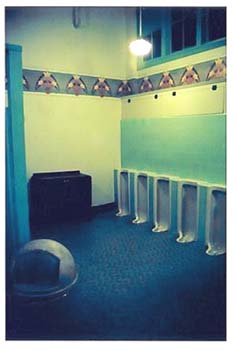 | |
| { Ritualistic Practices Observed While Using Public Restrooms } Jennifer Meccariello Using a public restroom is a commonplace and strange event. Everyone has to use them, yet experiences, rituals, and behaviors range from the lax to the very regimented. The whole process can be broken into six steps, commonly shared between sexes and among the various styles of fixtures, receptacles, and floor plans found in these very necessary rooms. Male, 29: If there are partition urinals, that's usually a pretty good bathroom, but it doesn't happen very often. I get the stage fright, so I try to find a urinal that's two or three spaces away from someone else, if it's a big bathroom. I do unzip while I'm walking to the urinal. It saves time. Why not?
If the first stall is occupied or someone has defied logic before you and left residue of their illogical behavior, I systematically go down the line of unoccupied stalls, kicking open each door to get a feel of the general level of filth contained within. Female, 23: [Speaking of restroom at her work] To the right are three small stalls, but I never like to go in them because someone is always in them. To the left is a line of longer stalls. I always look at the small stalls first because I like to wash my face and brush my teeth at those sinks more because no one will see me. But I always walk back there to check just in case. Then I go to the stalls on the longer part of the wall; I either go to the very first stall or the very last one. I don't like the middle stall. I don't like the handicapped ones, either, because more people go in them. Situations that can be worked with to produce a comfortable situation:
This is, of course, in the case of a multi-stalled facility. In the case of a smaller restroom, the choosing portion of the regimen must be eschewed, and I simply move on to preparing to alight the throne. Female, 25: If there's a hook, I'll use it. But a lot of times, I'll just put the handle of my purse around my neck. Especially if I'm at a bar. Male, 24: If it's wet, I wipe it down. But I do not sit on toilet paper. If the seat is oblong, three pieces of toilet paper are used, one on each side and one in the middle, regardless of whether the seat is joined in the middle-front section or not. If the toilet is old, it invariably has a round seat, and in this instance toilet paper must be lain over the entire seat to protect the back of your tush. This takes approximately one and a half minutes from hanging up my coat to finally sitting down. Male, 26: The big thing is, when you go to the bathroom, the first decision you have to make is if you have to urinate or do you have to defecate? And if it's a defecation situation, first of all, is the bathroom clean enough? But ultimately, what no one else seems to do, which I think is weird—we call it "building a nest" where I come from. You take as much toilet paper as you possibly can and wad it up into a huge, enormous ball and you drop that into the toilet so that you're not going to get any splashing. It will, conceivably, clog the toilet. At a former place of employment of mine, there was an automatic toilet seat that, once pressed, would, for lack of a better word, blow a fresh plastic-wrapping around the toilet seat, taking away the entire process of cleaning the seat. It was amazing. Male, 23: I never, ever flush a public urinal because they never, ever work—it just puts more water in there that never drains. And I don't want to touch that whole thing. If I'm using a stall bathroom, I hit it with my foot. Female, 19: There's a sink at the far end in the corner that has the soap container open instead of having a built-in pump, and I use that one because the other sinks don't have soap. I hate the faucet taps. Sometimes I'll clean them off because I can't stand looking at those. | |
 Male, 23: I think the only thing you actually look for in a urinal is how much urine is actually on the floor below it, because it tends to puddle. You don't really like the low urinal, the little-kid-slash-midget urinal—you can pee in it, but you could also pee on top of it if you're not really paying attention.
Male, 23: I think the only thing you actually look for in a urinal is how much urine is actually on the floor below it, because it tends to puddle. You don't really like the low urinal, the little-kid-slash-midget urinal—you can pee in it, but you could also pee on top of it if you're not really paying attention.